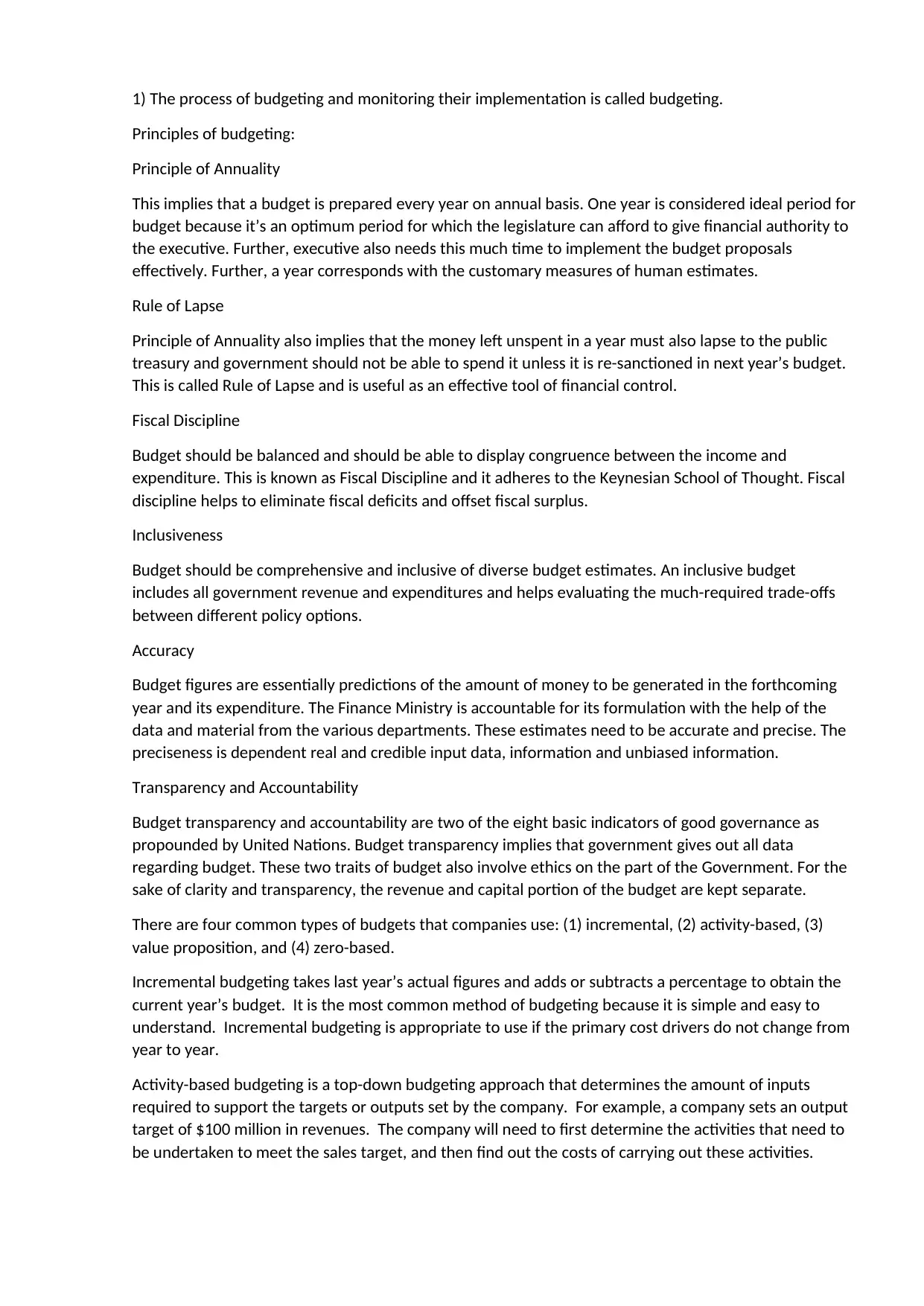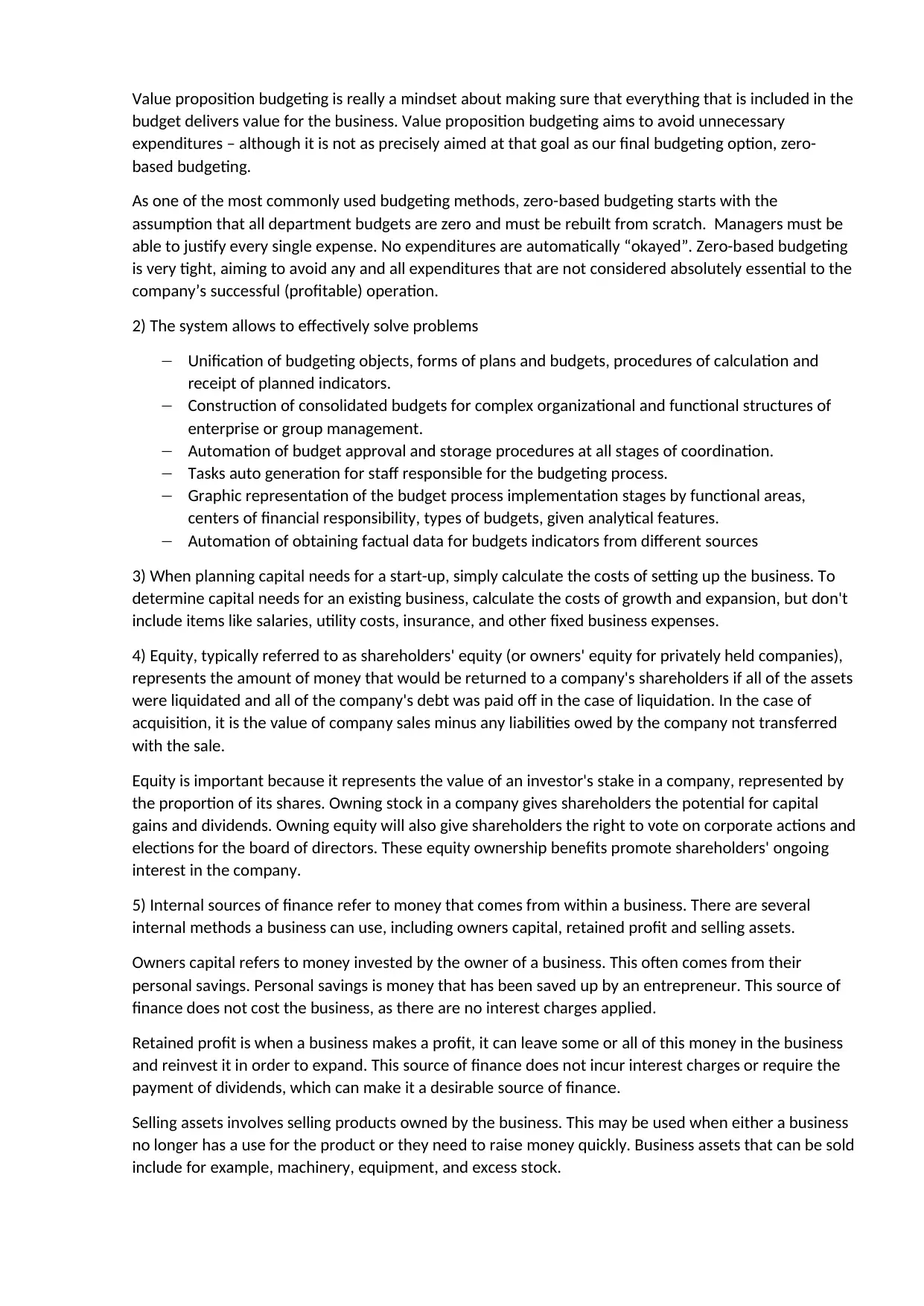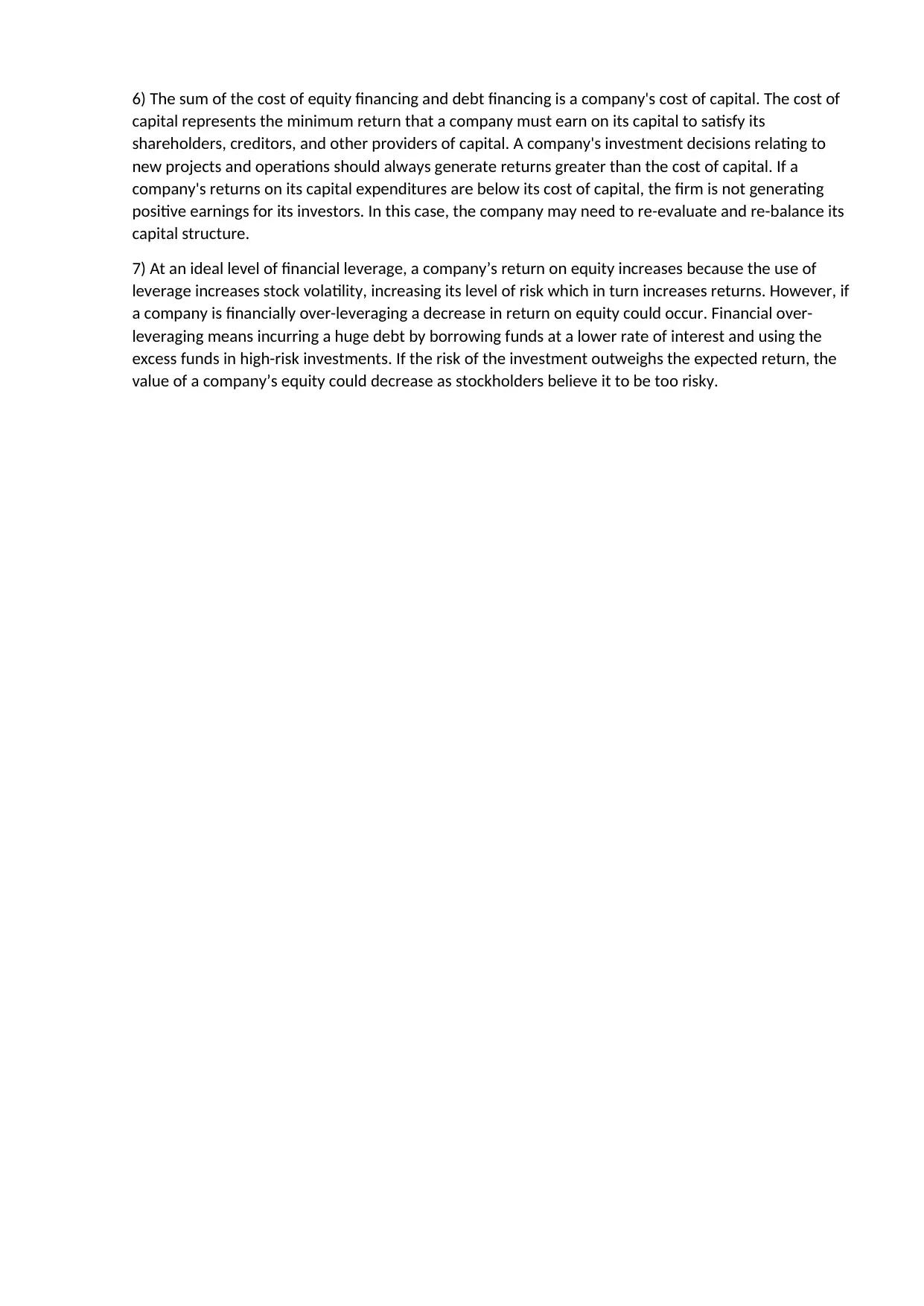Finance: Budgeting, Capital, and Leverage Explained
VerifiedAdded on 2022/10/14
|3
|1403
|23
Homework Assignment
AI Summary
This assignment covers fundamental finance concepts. It begins by defining budgeting and outlining its core principles, including annuality, rule of lapse, fiscal discipline, inclusiveness, accuracy, and transparency. It then explores four common budgeting types: incremental, activity-based, value proposition, and zero-based. The assignment also addresses the importance of automation in budgeting systems. The assignment further explores the calculation of capital needs for startups and existing businesses and defines equity, emphasizing its significance for investors. It then examines internal sources of finance, such as owner's capital, retained profit, and asset sales. The assignment also defines the cost of capital and how it relates to investment decisions, as well as financial leverage, discussing its impact on return on equity and the potential risks associated with over-leveraging.

1) The process of budgeting and monitoring their implementation is called budgeting.
Principles of budgeting:
Principle of Annuality
This implies that a budget is prepared every year on annual basis. One year is considered ideal period for
budget because it’s an optimum period for which the legislature can afford to give financial authority to
the executive. Further, executive also needs this much time to implement the budget proposals
effectively. Further, a year corresponds with the customary measures of human estimates.
Rule of Lapse
Principle of Annuality also implies that the money left unspent in a year must also lapse to the public
treasury and government should not be able to spend it unless it is re-sanctioned in next year’s budget.
This is called Rule of Lapse and is useful as an effective tool of financial control.
Fiscal Discipline
Budget should be balanced and should be able to display congruence between the income and
expenditure. This is known as Fiscal Discipline and it adheres to the Keynesian School of Thought. Fiscal
discipline helps to eliminate fiscal deficits and offset fiscal surplus.
Inclusiveness
Budget should be comprehensive and inclusive of diverse budget estimates. An inclusive budget
includes all government revenue and expenditures and helps evaluating the much-required trade-offs
between different policy options.
Accuracy
Budget figures are essentially predictions of the amount of money to be generated in the forthcoming
year and its expenditure. The Finance Ministry is accountable for its formulation with the help of the
data and material from the various departments. These estimates need to be accurate and precise. The
preciseness is dependent real and credible input data, information and unbiased information.
Transparency and Accountability
Budget transparency and accountability are two of the eight basic indicators of good governance as
propounded by United Nations. Budget transparency implies that government gives out all data
regarding budget. These two traits of budget also involve ethics on the part of the Government. For the
sake of clarity and transparency, the revenue and capital portion of the budget are kept separate.
There are four common types of budgets that companies use: (1) incremental, (2) activity-based, (3)
value proposition, and (4) zero-based.
Incremental budgeting takes last year’s actual figures and adds or subtracts a percentage to obtain the
current year’s budget. It is the most common method of budgeting because it is simple and easy to
understand. Incremental budgeting is appropriate to use if the primary cost drivers do not change from
year to year.
Activity-based budgeting is a top-down budgeting approach that determines the amount of inputs
required to support the targets or outputs set by the company. For example, a company sets an output
target of $100 million in revenues. The company will need to first determine the activities that need to
be undertaken to meet the sales target, and then find out the costs of carrying out these activities.
Principles of budgeting:
Principle of Annuality
This implies that a budget is prepared every year on annual basis. One year is considered ideal period for
budget because it’s an optimum period for which the legislature can afford to give financial authority to
the executive. Further, executive also needs this much time to implement the budget proposals
effectively. Further, a year corresponds with the customary measures of human estimates.
Rule of Lapse
Principle of Annuality also implies that the money left unspent in a year must also lapse to the public
treasury and government should not be able to spend it unless it is re-sanctioned in next year’s budget.
This is called Rule of Lapse and is useful as an effective tool of financial control.
Fiscal Discipline
Budget should be balanced and should be able to display congruence between the income and
expenditure. This is known as Fiscal Discipline and it adheres to the Keynesian School of Thought. Fiscal
discipline helps to eliminate fiscal deficits and offset fiscal surplus.
Inclusiveness
Budget should be comprehensive and inclusive of diverse budget estimates. An inclusive budget
includes all government revenue and expenditures and helps evaluating the much-required trade-offs
between different policy options.
Accuracy
Budget figures are essentially predictions of the amount of money to be generated in the forthcoming
year and its expenditure. The Finance Ministry is accountable for its formulation with the help of the
data and material from the various departments. These estimates need to be accurate and precise. The
preciseness is dependent real and credible input data, information and unbiased information.
Transparency and Accountability
Budget transparency and accountability are two of the eight basic indicators of good governance as
propounded by United Nations. Budget transparency implies that government gives out all data
regarding budget. These two traits of budget also involve ethics on the part of the Government. For the
sake of clarity and transparency, the revenue and capital portion of the budget are kept separate.
There are four common types of budgets that companies use: (1) incremental, (2) activity-based, (3)
value proposition, and (4) zero-based.
Incremental budgeting takes last year’s actual figures and adds or subtracts a percentage to obtain the
current year’s budget. It is the most common method of budgeting because it is simple and easy to
understand. Incremental budgeting is appropriate to use if the primary cost drivers do not change from
year to year.
Activity-based budgeting is a top-down budgeting approach that determines the amount of inputs
required to support the targets or outputs set by the company. For example, a company sets an output
target of $100 million in revenues. The company will need to first determine the activities that need to
be undertaken to meet the sales target, and then find out the costs of carrying out these activities.
Paraphrase This Document
Need a fresh take? Get an instant paraphrase of this document with our AI Paraphraser

Value proposition budgeting is really a mindset about making sure that everything that is included in the
budget delivers value for the business. Value proposition budgeting aims to avoid unnecessary
expenditures – although it is not as precisely aimed at that goal as our final budgeting option, zero-
based budgeting.
As one of the most commonly used budgeting methods, zero-based budgeting starts with the
assumption that all department budgets are zero and must be rebuilt from scratch. Managers must be
able to justify every single expense. No expenditures are automatically “okayed”. Zero-based budgeting
is very tight, aiming to avoid any and all expenditures that are not considered absolutely essential to the
company’s successful (profitable) operation.
2) The system allows to effectively solve problems
Unification of budgeting objects, forms of plans and budgets, procedures of calculation and
receipt of planned indicators.
Construction of consolidated budgets for complex organizational and functional structures of
enterprise or group management.
Automation of budget approval and storage procedures at all stages of coordination.
Tasks auto generation for staff responsible for the budgeting process.
Graphic representation of the budget process implementation stages by functional areas,
centers of financial responsibility, types of budgets, given analytical features.
Automation of obtaining factual data for budgets indicators from different sources
3) When planning capital needs for a start-up, simply calculate the costs of setting up the business. To
determine capital needs for an existing business, calculate the costs of growth and expansion, but don't
include items like salaries, utility costs, insurance, and other fixed business expenses.
4) Equity, typically referred to as shareholders' equity (or owners' equity for privately held companies),
represents the amount of money that would be returned to a company's shareholders if all of the assets
were liquidated and all of the company's debt was paid off in the case of liquidation. In the case of
acquisition, it is the value of company sales minus any liabilities owed by the company not transferred
with the sale.
Equity is important because it represents the value of an investor's stake in a company, represented by
the proportion of its shares. Owning stock in a company gives shareholders the potential for capital
gains and dividends. Owning equity will also give shareholders the right to vote on corporate actions and
elections for the board of directors. These equity ownership benefits promote shareholders' ongoing
interest in the company.
5) Internal sources of finance refer to money that comes from within a business. There are several
internal methods a business can use, including owners capital, retained profit and selling assets.
Owners capital refers to money invested by the owner of a business. This often comes from their
personal savings. Personal savings is money that has been saved up by an entrepreneur. This source of
finance does not cost the business, as there are no interest charges applied.
Retained profit is when a business makes a profit, it can leave some or all of this money in the business
and reinvest it in order to expand. This source of finance does not incur interest charges or require the
payment of dividends, which can make it a desirable source of finance.
Selling assets involves selling products owned by the business. This may be used when either a business
no longer has a use for the product or they need to raise money quickly. Business assets that can be sold
include for example, machinery, equipment, and excess stock.
budget delivers value for the business. Value proposition budgeting aims to avoid unnecessary
expenditures – although it is not as precisely aimed at that goal as our final budgeting option, zero-
based budgeting.
As one of the most commonly used budgeting methods, zero-based budgeting starts with the
assumption that all department budgets are zero and must be rebuilt from scratch. Managers must be
able to justify every single expense. No expenditures are automatically “okayed”. Zero-based budgeting
is very tight, aiming to avoid any and all expenditures that are not considered absolutely essential to the
company’s successful (profitable) operation.
2) The system allows to effectively solve problems
Unification of budgeting objects, forms of plans and budgets, procedures of calculation and
receipt of planned indicators.
Construction of consolidated budgets for complex organizational and functional structures of
enterprise or group management.
Automation of budget approval and storage procedures at all stages of coordination.
Tasks auto generation for staff responsible for the budgeting process.
Graphic representation of the budget process implementation stages by functional areas,
centers of financial responsibility, types of budgets, given analytical features.
Automation of obtaining factual data for budgets indicators from different sources
3) When planning capital needs for a start-up, simply calculate the costs of setting up the business. To
determine capital needs for an existing business, calculate the costs of growth and expansion, but don't
include items like salaries, utility costs, insurance, and other fixed business expenses.
4) Equity, typically referred to as shareholders' equity (or owners' equity for privately held companies),
represents the amount of money that would be returned to a company's shareholders if all of the assets
were liquidated and all of the company's debt was paid off in the case of liquidation. In the case of
acquisition, it is the value of company sales minus any liabilities owed by the company not transferred
with the sale.
Equity is important because it represents the value of an investor's stake in a company, represented by
the proportion of its shares. Owning stock in a company gives shareholders the potential for capital
gains and dividends. Owning equity will also give shareholders the right to vote on corporate actions and
elections for the board of directors. These equity ownership benefits promote shareholders' ongoing
interest in the company.
5) Internal sources of finance refer to money that comes from within a business. There are several
internal methods a business can use, including owners capital, retained profit and selling assets.
Owners capital refers to money invested by the owner of a business. This often comes from their
personal savings. Personal savings is money that has been saved up by an entrepreneur. This source of
finance does not cost the business, as there are no interest charges applied.
Retained profit is when a business makes a profit, it can leave some or all of this money in the business
and reinvest it in order to expand. This source of finance does not incur interest charges or require the
payment of dividends, which can make it a desirable source of finance.
Selling assets involves selling products owned by the business. This may be used when either a business
no longer has a use for the product or they need to raise money quickly. Business assets that can be sold
include for example, machinery, equipment, and excess stock.

6) The sum of the cost of equity financing and debt financing is a company's cost of capital. The cost of
capital represents the minimum return that a company must earn on its capital to satisfy its
shareholders, creditors, and other providers of capital. A company's investment decisions relating to
new projects and operations should always generate returns greater than the cost of capital. If a
company's returns on its capital expenditures are below its cost of capital, the firm is not generating
positive earnings for its investors. In this case, the company may need to re-evaluate and re-balance its
capital structure.
7) At an ideal level of financial leverage, a company’s return on equity increases because the use of
leverage increases stock volatility, increasing its level of risk which in turn increases returns. However, if
a company is financially over-leveraging a decrease in return on equity could occur. Financial over-
leveraging means incurring a huge debt by borrowing funds at a lower rate of interest and using the
excess funds in high-risk investments. If the risk of the investment outweighs the expected return, the
value of a company’s equity could decrease as stockholders believe it to be too risky.
capital represents the minimum return that a company must earn on its capital to satisfy its
shareholders, creditors, and other providers of capital. A company's investment decisions relating to
new projects and operations should always generate returns greater than the cost of capital. If a
company's returns on its capital expenditures are below its cost of capital, the firm is not generating
positive earnings for its investors. In this case, the company may need to re-evaluate and re-balance its
capital structure.
7) At an ideal level of financial leverage, a company’s return on equity increases because the use of
leverage increases stock volatility, increasing its level of risk which in turn increases returns. However, if
a company is financially over-leveraging a decrease in return on equity could occur. Financial over-
leveraging means incurring a huge debt by borrowing funds at a lower rate of interest and using the
excess funds in high-risk investments. If the risk of the investment outweighs the expected return, the
value of a company’s equity could decrease as stockholders believe it to be too risky.
⊘ This is a preview!⊘
Do you want full access?
Subscribe today to unlock all pages.

Trusted by 1+ million students worldwide
1 out of 3
Your All-in-One AI-Powered Toolkit for Academic Success.
+13062052269
info@desklib.com
Available 24*7 on WhatsApp / Email
![[object Object]](/_next/static/media/star-bottom.7253800d.svg)
Unlock your academic potential
Copyright © 2020–2025 A2Z Services. All Rights Reserved. Developed and managed by ZUCOL.

